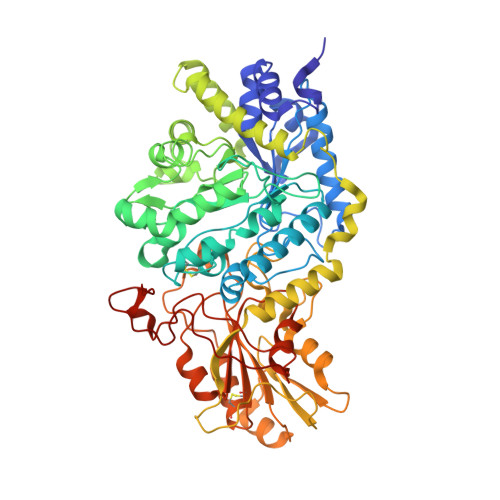Discovery of processive catalysis by an exo-hydrolase with a pocket-shaped active site.
Streltsov, V.A., Luang, S., Peisley, A., Varghese, J.N., Ketudat Cairns, J.R., Fort, S., Hijnen, M., Tvaroska, I., Arda, A., Jimenez-Barbero, J., Alfonso-Prieto, M., Rovira, C., Mendoza, F., Tiessler-Sala, L., Sanchez-Aparicio, J.E., Rodriguez-Guerra, J., Lluch, J.M., Marechal, J.D., Masgrau, L., Hrmova, M.(2019) Nat Commun 10: 2222-2222
- PubMed: 31110237
- DOI: https://doi.org/10.1038/s41467-019-09691-z
- Primary Citation of Related Structures:
3WLH, 3WLI, 3WLJ, 3WLK, 3WLL, 3WLM, 3WLN, 3WLO, 3WLP, 3WLQ, 3WLR, 6MD6, 6MI1 - PubMed Abstract:
Substrates associate and products dissociate from enzyme catalytic sites rapidly, which hampers investigations of their trajectories. The high-resolution structure of the native Hordeum exo-hydrolase HvExoI isolated from seedlings reveals that non-covalently trapped glucose forms a stable enzyme-product complex. Here, we report that the alkyl β-D-glucoside and methyl 6-thio-β-gentiobioside substrate analogues perfused in crystalline HvExoI bind across the catalytic site after they displace glucose, while methyl 2-thio-β-sophoroside attaches nearby. Structural analyses and multi-scale molecular modelling of nanoscale reactant movements in HvExoI reveal that upon productive binding of incoming substrates, the glucose product modifies its binding patterns and evokes the formation of a transient lateral cavity, which serves as a conduit for glucose departure to allow for the next catalytic round. This path enables substrate-product assisted processive catalysis through multiple hydrolytic events without HvExoI losing contact with oligo- or polymeric substrates. We anticipate that such enzyme plasticity could be prevalent among exo-hydrolases.
- Commonwealth Scientific and Industrial Research Organisation, Materials Science and Engineering, Parkville Victoria, 3052, Australia.
Organizational Affiliation:




















